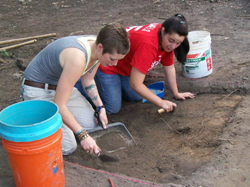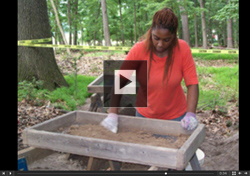Digging history at Valley Forge
|
Driving along Route 23 through Valley Forge National Park, just west of the Washington Memorial Chapel, you may spot a scene that looks like something out of the TV show CSI. In a small grove of woods, within an area marked off by yellow caution tape, nearly a dozen people are carefully digging in the ground, searching for clues. But they’re not trying to solve a crime; instead they are searching for evidence of the Continental Army’s encampment here from Dec. 1777 through June 1778. Temple anthropology doctoral student |
Preston Moretz
Slide show: Click on the image above to see pictures of the dig with audio commentary. In the picture shown here, socio-cultural anthropology senior Nikki Bond sifts through excavated dirt looking for artifacts. So far, she has uncovered nails, glass and pot shards from the soldiers’ encampment.
|
|
Although Boone said they have not yet found definitive evidence of who was encamped at the site where they are digging, she believes it could be part of Rhode Island General James Varnum’s brigade, which encamped near the area. She said evidence unearthed at two separate areas near the road include the remnants of a large hut hearth and possibly a camp kitchen. “There were definitely huts here,” she said. According to Boone, Temple Anthropology Professor David Orr, a former chief archaeologist for the Mideast Region for the National Park Service who has done extensive excavations at the park, has said this hut hearth is larger than any previously unearthed at Valley Forge. “That tells us something about who may have been here,” she said. “If it’s a bigger hut that was here, it may have been a hut for officers.” |
|
 Preston Moretz
Meghan Shirley (left) and Emily Suarez use a trowel to lift the soil while excavating a 5x5-ft square. They will then collect the dirt in the buckets and sift through it looking for potential artifacts. |
So far this summer, Boone and her students have unearthed two musket balls, window glass, nails used for hut construction, bottle glass and lots of food bones. Some of the food bones are so big the butcher’s knife marks can be identified. Boone said the most impressive artifact unearthed on the site, aside from the hut hearth, is a uniform button found in 2007 that reads “USA 1777.” It is one of only about three or four known to exist. “General George Washington gave a directive to all the state regiments that they were to remove their state uniform buttons and replace them with the USA button,” she explained. “He gave that directive in September 1777 and we know that the first units arrived here in Dec. 19, 1777. That’s a four-month interval. |
|
“That’s really good context for archaeology,” she added. “We often talk in hundreds, even thousands, of years depending upon what type of archaeology you’re talking about.” Boone said the students in the field school are learning technical skills and theoretical interpretation of history, the “nitty-gritty of how to be an archaeologist. They’re learning how to take a flat shovel and dig in square layers as opposed to just digging holes.” For Temple senior Nikki Bond, who is majoring in socio-cultural anthropology, this is her first time doing anthropology and archaeology in the field. “I’ve learned a lot out here,” she said. “I think hands-on experience is just as important as being in the classroom studying. You can learn it and memorize it in the classroom, but until you get out here in the field you won’t know how to use a trowel to dig or how to shovel without disturbing the artifact that might be underneath the surface, so this is very, very important.” Bond has found nails, glass and pot shards while excavating the site, but is hoping to find a musket ball or button. “Whenever you find something, it’s always exciting,” she said. “The first time I found an artifact, I knew what it was, because, like I said, you sit in the classroom and you learn about these things. But when you get in the field and actually find it, I was like, ‘Yes!’” Although the site is located within Valley Forge National Park, it is actually private property belonging to the Washington Memorial Chapel. “Everything we find is property of the chapel,” said Boone. “We’re processing the artifacts at Temple, we’re housing them properly for storage in perpetuity and then we’re going to give them back to the chapel with advice on how to store and display them." |
|
